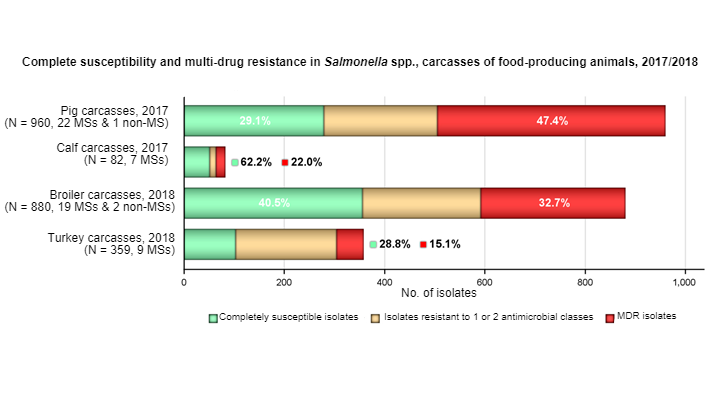The latest data from humans, animals, and food show that a large proportion of Salmonella bacteria are multidrug-resistant (resistant to three or more antimicrobials). In humans, resistance to ciprofloxacin is common, particularly in certain types of Salmonella, and resistance to high concentrations of ciprofloxacin increased overall from 1.7% (2016) to 4.6% (2018). For Campylobacter, 16 out of 19 countries report very high or extremely high percentages of ciprofloxacin resistance.

MDR and complete susceptibility levels are also expressed as a percentage; N: total number of Salmonella spp. reported by MSs and non‐MSs.

High proportions of resistance to ciprofloxacin are also reported in Salmonella and E. coli bacteria from poultry. Ciprofloxacin is a fluoroquinolone, a class of antimicrobials categorised as critically important for use in humans. If fluoroquinolones lose their effectiveness, the impact on human health could be significant.
In food-producing animals, the summary indicator of susceptibility to all antimicrobials has increased in E. coli in just under 25% of Member States (6) over the period 2014-2018. This is a positive development as it means that in these countries, in case of need, treatments with antimicrobials would have a higher chance to be successful. Decreasing trends in the occurrence of extended-spectrum β-lactamase (ESBL) or AmpC-producing E. coli have been observed in about 40% Member States (11) during 2015-2018. This is also important because ESBL-AmpC producing E. coli are responsible for serious infections in humans.
Regarding last-line antimicrobials, resistance to colistin was not common in Salmonella and E. coli, and carbapenemase-producing E. coli were not detected in broilers, turkeys and broiler meat.
In humans, the decline in resistance to ampicillin and to tetracyclines in Salmonella Typhimurium in many countries is another encouraging trend observed in 2013-2018.
To see the complete report, click here.
March 3, 2020/ EFSA/ EU.
http://www.efsa.europa.eu/





